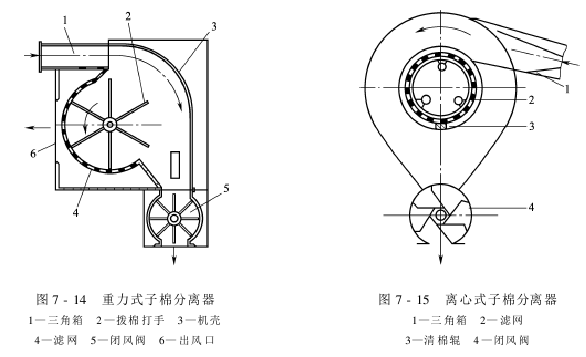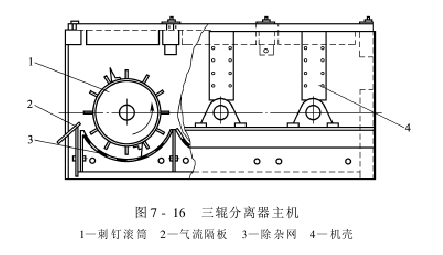Cotton management, cotton cleaning machinery
(2) Cotton suction separator
The cotton suction separator is actually a cotton separator, also known as a cotton unloader. Its main function is to separate the cotton from the air, the carrier for transporting the cotton, so that the cotton can enter the next process. It can also effectively remove light and small impurities in the cotton, such as dust, cotton leaves, etc. The main structural forms of cotton separators are as follows.
1. Gravity type cotton separator
Gravity type cotton separator is also called curved flow cotton separator and reverse fixed mesh type cotton separator. Its structure is shown in Figure 7-14.
The casing isolates the internal space of the separator from the outside atmosphere. The filter screen is made into an arc-shaped cross-section and fixed in the body of the separator to block the loose particles and allow air and small impurities to be discharged from the mesh. The cotton beater is used to knock off a small amount of molecular cotton attached to the surface of the filter and clean the surface of the filter. The diameter of the cotton beating hand is generally 700~1000mm, and the rotation speed is 150~200r/min. The air closing valve removes the cotton from the separator and also acts as a seal. The cotton suction port, which is the cotton inlet, is connected to the cotton suction tube through a variable cross-section tube (triangular box). The air outlet is the outlet for dust-laden air and is connected to the return air duct through a variable cross-section pipe. The gravity type cotton separator has the following advantages:
(1) Small pressure loss (400~500Pa) and low energy consumption.
(2) The fibers are not damaged during the separation process of cotton and air.
(3) Simple structure, easy installation, maintenance and operation.
2. Centrifugal cotton separator
Centrifugal cotton separator, also called rotary mesh cotton separator, has a structure as shown in Figure 7-15. It is mainly composed of arc-shaped shell, cylindrical filter screen, air closing valve and other parts.

Centrifugal The casing of the cotton separator is arc-shaped with an arc radius of 700mm. When the cotton enters the separator from the cotton inlet, it is restricted by the arc-shaped shell and is forced to move in a circle. The cylindrical filter is located at the center of the separator, with a diameter of 600mm and a rotating speed of 5 to 10r/mm. The cylindrical filter has a large ventilation area, which slightly reduces the filtering wind speed of dust-laden air. This is the main reason why the centrifugal cotton separator has a small pressure loss. The cleaning roller is usually a fixed brush bar, which is used to clean the surface of the cylindrical filter and keep the mesh open.
The centrifugal cotton separator has the following advantages:
(1) Small pressure loss (generally around 400Pa) and small air leakage rate (generally around 20%).
(2) During the separation process of cotton and air, the occurrence of neps and cord defects is completely eliminated.
(3) Simple structure and stable performance.
3. Three-roller separator
The structure of the main machine of the three-roller separator is shown in Figure 7-16. It is mainly composed of a casing, a spike roller, an impurity removal net, an air flow partition, etc.

3 The spike rollers are arranged horizontally and parallelly, with the same rotation direction and allowing the cotton to pass through the upper part of the roller. A four-blade rubber scraper is symmetrically installed on each spike roller, and the rubber plate extends 9.5mm beyond the top of the spikes. The gap between the top of the rubber scraper and the impurity removal net is generally 0 to 0.5mm. The outer diameter of the three spike rollers is 382mm, the rotation speed is 611r/min, and the center distance between the rollers is 407mm.
The impurity removal net is punched out of a 2.5mm thick steel plate, with a mesh aperture of 3.5mm and a mesh arc of 130° to 135°. The air flow baffle is installed at the outlet of the sub-cotton. Its function is to cut off the air flow generated when the spike drum rotates and prevent the sub-cotton from being brought back by the roller. For this purpose, the gap between the end of the airflow baffle and the top of the squeegee must be small enough.
After the cotton enters the separator with the air flow, it relies on the rotation of the three spike rollers to be loosened and relaxed toward the cotton outlet. Dust particles and other small impurities are separated from the cotton during the loosening process, and pass through the mesh of the impurity removal screen and enter the return air duct under the action of air flow.
Compared with gravity and centrifugal separators, the three-roller separator has the advantage of loosening the cotton clumps. When used as an external suction cotton separator, the cotton can be uniformly and loosely distributed into the hot air duct and The dryer is helpful to improve the uniformity and drying efficiency of cotton. However, the pressure loss of the three-roller separator is large (generally around 1000Pa), and the small flower head has a large loss.
AAA57865ERT34GSD







